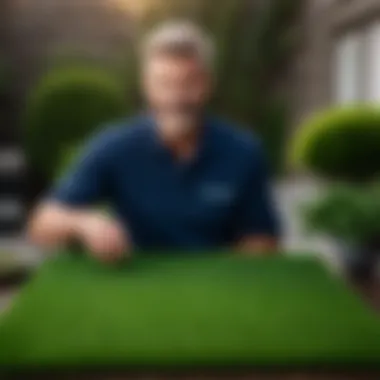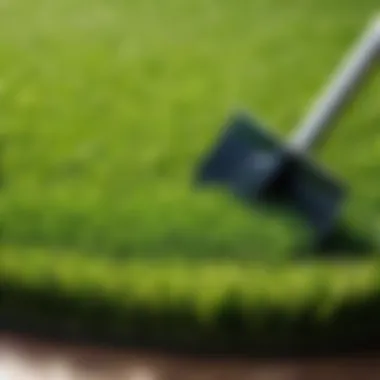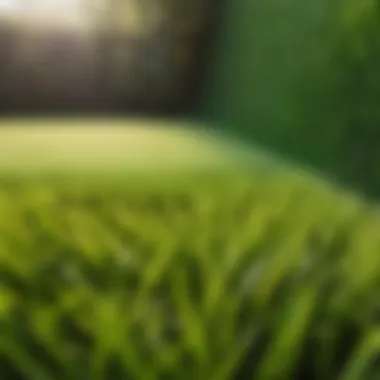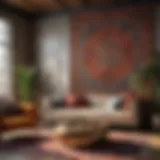Materials:
- Artificial grass rolls x6, measuring 15ft x 10ft each
- Weed barrier fabric, 6ft wide and 60ft long
- Class II road base, 4 inches thick
- Decomposed granite, 2 inches thick
- Bender board, 2in x 4in x 20ft
- Galvanized nails, 6-inch
- Turf seam tape
- Turf adhesive
DIY Steps:
-
Preparation: Excavate existing turf and soil to a depth of 4 inches. Compact the soil and add a 2-inch layer of decomposed granite followed by 4 inches of class II road base. Compact each layer thoroughly.
-
Installation: Roll out the artificial grass over the prepared base, allowing it to acclimate for a few hours. Trim edges to fit the area using a utility knife. Secure the seams with turf seam tape and adhesive.
-
Finishing: Install bender boards along the perimeter using galvanized nails to secure the edges of the turf. Trim any excess turf carefully for a clean finish.
Technical Aspects:
- Tools: Utility knife, nail gun, wheelbarrow, shovel, tape measure, vibrating plate compactor
- Timing: The entire process may take 1-2 days, depending on the size of the area
- Techniques: Ensure proper drainage by sloping the base away from buildings
DIY Project Process:


- Start by accurately measuring the area to determine the amount of materials needed
- Follow the sequential steps to ensure a proper installation, avoiding wrinkles or uneven surfaces
- Troubleshooting Tips: If there are visible wrinkles, lift the affected area and re-smooth the base before reattaching the turf
Introduction


In the realm of landscaping, the decision to replace a natural lawn with artificial grass is a significant one that carries various financial implications and benefits. This critical shift from traditional grass to synthetic turf is becoming increasingly popular among homeowners seeking a low-maintenance and visually appealing alternative to constant lawn upkeep. The introduction of artificial grass marks a substantial change in the aesthetic and practicality of outdoor spaces. Embracing this transition requires a thorough understanding of the costs involved, the installation process, as well as the long-term savings and environmental impact. Therefore, this article aims to delve deep into the financial considerations associated with making the switch from natural turf to artificial grass, empowering readers to make informed decisions regarding their landscaping choices.
Artificial grass offers a range of advantages that make it an appealing option for homeowners. Its low maintenance requirements, durability, and capacity to withstand various weather conditions are key selling points that appeal to those seeking a lush, green lawn without the hassle of mowing, watering, and fertilizing. Additionally, the aesthetic appeal and consistency of artificial turf provide a visually appealing landscape year-round, enhancing curb appeal and property value. Moreover, the initial investment in artificial grass can lead to long-term savings by eliminating the need for ongoing lawn care, reducing water consumption, and minimizing the use of chemicals and pesticides.
When considering the transition from a traditional lawn to artificial grass, homeowners must take into account various elements such as the quality of the turf, the size of the lawn, and labor costs. These factors play a crucial role in determining the overall cost of the replacement project and the level of customization desired. By focusing on these specific elements and understanding their impact on the budget, individuals can make informed decisions that align with their aesthetic preferences, financial capabilities, and long-term goals.
Factors Affecting Cost


Replacing a traditional lawn with artificial grass involves several factors that significantly impact the overall cost of the project. Understanding these factors is crucial in making informed decisions about transitioning to artificial turf.
Quality of Artificial Grass
The quality of artificial grass plays a pivotal role in determining the overall cost of the installation. Higher quality grass tends to be more expensive upfront but offers greater longevity and a more realistic appearance. Factors such as pile height, density, and backing material influence the quality and, consequently, the pricing of artificial grass.
Size of the Lawn
The size of the lawn is a fundamental element in calculating the cost of replacing it with artificial grass. Larger lawns require more materials and labor, leading to increased expenses. The square footage of the area to be covered dictates the amount of artificial grass needed, base materials required, and the duration of the installation process. Understanding the size of the lawn is essential in estimating the overall cost accurately.
Labor Costs
Labor costs form a significant portion of the expenses incurred when replacing a traditional lawn with artificial grass. Professional installation services come with a price tag that varies based on factors such as the complexity of the project, accessibility of the site, and the experience of the installers. DIY alternatives may seem cost-effective initially, but inexperienced installation can lead to additional expenses in repairs and adjustments. Considering labor costs is vital in budgeting for the transition to artificial turf.
Initial Investment
When considering the cost to replace a natural lawn with artificial grass, the initial investment plays a crucial role in the decision-making process. The initial investment encompasses the total expenditure required to kickstart the transformation from a traditional lawn to artificial turf. This section delves into the specifics, benefits, and considerations that homeowners need to factor in when evaluating the initial investment.
Specific Elements
The initial investment includes costs associated with purchasing artificial grass, base materials, accessories, and installation services. Homeowners need to carefully evaluate the quality and type of artificial grass they intend to use, as it can significantly impact the overall cost. Additionally, considering the size of the lawn is essential, as larger areas will require more materials and labor, ultimately affecting the initial investment.
Benefits
While the initial investment may seem substantial upfront, it offers long-term benefits that outweigh the initial costs. Artificial grass is a low-maintenance landscaping option, reducing the need for regular watering, mowing, and fertilizing. This results in cost savings on water bills, lawn maintenance services, and landscaping equipment over the years, making it a financially prudent choice in the long run.
Considerations about Initial Investment
To ensure an accurate assessment of the initial investment, homeowners should seek quotes from reputable artificial grass suppliers and installation professionals. Comparing multiple quotes can help in understanding the average market prices and selecting a cost-effective option without compromising on the quality of materials or services. Moreover, factoring in any additional preparatory work or services required before the installation can prevent unexpected costs down the line.
Materials Needed
In the realm of replacing a traditional lawn with artificial grass, understanding the materials required is paramount. The choice of materials can significantly impact the overall outcome, durability, and aesthetic appeal of the synthetic turf. These materials play a crucial role in ensuring a successful transition to an artificial grass landscape. When it comes to Materials Needed for such a project, several key elements come into play.
Artificial Grass
Artificial grass is the central component of transforming a natural lawn into a low-maintenance, lush green artificial landscape. The quality of artificial grass chosen is vital, as it determines the overall look, feel, and longevity of the turf. Factors such as material composition, pile height, density, and backing influence the cost and performance of the fake grass. Opting for premium artificial grass made from high-quality materials enhances the aesthetic appeal and lifespan of the turf, providing a realistic and comfortable surface for various activities.
Base Materials
Alongside artificial grass, base materials are essential for creating a stable foundation for the synthetic turf. These materials include aggregates like crushed rock, decomposed granite, or sand, which provide drainage, support, and leveling for the artificial grass. Properly preparing the base ensures proper water drainage, prevents uneven surfaces, and enhances the longevity of the synthetic lawn. The selection and quality of base materials impact the durability and performance of the artificial grass, making it crucial to choose materials that meet the requirements of the specific landscape and usage.
Accessories
In addition to artificial grass and base materials, various accessories are necessary to complete the installation and enhance the functionality of the synthetic turf. Accessories such as seaming tape, adhesives, nails, infill materials, and edging strips play a vital role in ensuring a professional and secure installation of artificial grass. These accessories aid in seam joining, securing the turf edges, providing cushioning, and enhancing the overall appearance of the synthetic lawn. Choosing high-quality accessories tailored to the artificial grass product and installation method is essential for achieving a seamless and long-lasting transformation from natural to artificial grass.
Installation Costs
When considering transitioning from a natural lawn to artificial grass, installation costs play a crucial role in the overall expenses. The process of transforming your yard involves various elements, each contributing to the final cost. Understanding the specifics of installation costs is essential for anyone looking to undertake this landscaping project.
Professional Installation vs. DIY
Choosing between professional installation and a do-it-yourself approach is a key decision when installing artificial grass. Opting for professional installation ensures that experienced experts handle the intricate process with precision. Professionals have the necessary skills and tools to deliver a seamless installation, reducing the chances of errors and ensuring a high-quality outcome. On the other hand, taking the DIY route may save on labor costs but requires a significant time commitment and a good understanding of the installation process. DIY installations can be labor-intensive and may result in subpar results if not done correctly.
Preparation Work
Before laying down artificial grass, thorough preparation work is essential to ensure a lasting and visually appealing installation. This stage involves removing existing turf, leveling the ground, and addressing any drainage issues. Proper preparation sets the foundation for a successful artificial grass installation by ensuring a flat surface that minimizes the risk of uneven patches or bumps. Neglecting preparation work can lead to issues such as poor drainage, which can affect the longevity and aesthetic appeal of the artificial turf.
Additional Services
Apart from the basic installation of artificial grass, additional services may be required depending on the specific needs of your lawn. These services can include features like edging, weed barrier installation, or custom designs. Incorporating additional services can enhance the overall aesthetic and functionality of your artificial grass lawn, providing a tailored landscaping solution. However, it is important to weigh the costs of these extra services against the benefits they bring to ensure they align with your budget and design vision.
Maintenance Expenses
In this comprehensive guide to replacing a traditional lawn with artificial grass, maintenance expenses hold significant weight in the overall cost analysis. When considering the transition to artificial turf, it is paramount to factor in the costs associated with maintaining the new lawn. By exploring maintenance expenses, individuals can gain a deeper understanding of the financial implications involved in opting for artificial grass over natural turf.
Maintenance expenses encompass various aspects that play a crucial role in prolonging the appearance and lifespan of artificial grass. Regular cleaning and brushing are essential tasks that contribute to the upkeep of the turf, ensuring its aesthetic appeal and durability over time. Additionally, addressing repairs and replacements promptly is vital to rectifying any damage and preserving the overall quality of the artificial lawn. Apart from these routine maintenance tasks, there are other considerations that homeowners should keep in mind to ensure the longevity and functionality of their artificial grass.
Cleaning and Brushing
Cleaning and brushing are fundamental maintenance tasks that help uphold the pristine condition of artificial grass. Removing debris, leaves, and other organic matter from the surface prevents the accumulation of dirt and maintains the grass' vibrant appearance. Brushing the fibers regularly not only enhances the grass's aesthetic appeal but also prevents matting, ensuring a consistent and lush look. By incorporating routine cleaning and brushing into the maintenance regimen, homeowners can preserve the cleanliness and visual appeal of their artificial lawn, promoting a welcoming outdoor environment.
Repairs and Replacements
Addressing repairs and replacements in a timely manner is essential for prolonging the lifespan of artificial grass. Whether due to wear and tear or accidental damage, attending to repairs promptly can prevent issues from escalating and affecting the overall integrity of the turf. Replacing damaged sections with precision ensures a seamless and cohesive look across the entire lawn, maintaining its aesthetic appeal and structural stability. By prioritizing repairs and replacements as part of the maintenance routine, homeowners can effectively manage any issues and sustain the longevity of their artificial grass investment.
Other Maintenance Tasks
In addition to regular cleaning, brushing, repairs, and replacements, there are other maintenance tasks that contribute to the overall upkeep of artificial grass. Tasks such as infill redistribution, checking drainage systems, and addressing compacted areas play a vital role in ensuring the optimal performance and longevity of the turf. By incorporating these additional maintenance steps into the regular care routine, homeowners can minimize potential issues, enhance the durability of the artificial lawn, and maximize the long-term benefits of transitioning to artificial grass.
Long-Term Savings
When considering the switch from a natural lawn to artificial grass, one aspect that holds significant weight is the long-term savings associated with this transition. By opting for artificial turf, homeowners can unlock a multitude of financial benefits that extend beyond the initial investment. One key element contributing to long-term savings is the minimal maintenance required for artificial grass. Unlike traditional lawns that demand constant watering, mowing, and fertilizing, artificial turf necessitates far less upkeep. This reduction in maintenance tasks translates to lower ongoing costs, saving homeowners both time and money in the long run.
Moreover, artificial grass is durable and resilient, lending itself to a longer lifespan compared to natural grass. This longevity directly translates to cost savings over the years, as homeowners are spared the expense of frequent reseeding, sodding, or replanting necessary with traditional lawns. The robust nature of artificial grass also means fewer expenses related to pest control and the use of herbicides or pesticides, contributing further to long-term financial savings.
Additionally, the water conservation benefits of artificial grass play a significant role in long-term savings. Natural lawns often incur substantial water bills due to irrigation needs, especially in dry or hot climates. Artificial turf, however, eliminates the need for extensive watering, leading to significant reductions in water consumption and associated costs over time. This eco-friendly aspect not only contributes to cost savings but also aligns with sustainable practices for a greener environment.
Furthermore, the aesthetic appeal and functionality of artificial grass remain intact year-round, requiring minimal touch-ups and enhancements. This consistency in appearance minimizes the need for costly landscaping services or products to maintain a pristine lawn, ultimately leading to long-term savings for homeowners. In essence, the long-term savings associated with replacing natural grass with artificial turf extend across various aspects, including reduced maintenance expenses, increased durability, water conservation benefits, and sustained visual appeal. By considering these financial advantages, homeowners can confidently embrace artificial grass as a cost-effective and efficient landscaping solution for the long term.
Comparative Analysis
In this article, the Comparative Analysis section plays a crucial role in providing readers with a comprehensive overview of the financial implications of opting to replace a traditional lawn with artificial grass. This segment serves as a crucial point of evaluation for individuals considering this landscaping transition, as it presents a detailed breakdown of the comparative costs and benefits associated with both natural grass and artificial turf.
By delving into the Comparative Analysis, readers gain valuable insights into the initial investment differences, long-term savings potential, and maintenance expenses of both options. They can weigh the cost-effectiveness of artificial grass against the ongoing expenses typically associated with maintaining a natural lawn. This section serves as a strategic tool for those seeking a financially sound and sustainable landscaping solution for their residential properties.
Moreover, the Comparative Analysis segment aids readers in understanding the environmental impact of choosing artificial grass over traditional turf. It highlights the ecological benefits of artificial grass, such as reduced water consumption, elimination of harmful pesticides or fertilizers, and decreased carbon emissions from lawn maintenance equipment. Readers can make informed environmental decisions based on a thorough comparison of the ecological footprints of natural grass versus artificial turf installations.
In essence, the Comparative Analysis section of this article equips readers with the necessary information to make educated choices regarding their lawn landscaping preferences. By presenting a blend of financial considerations and ecological assessments, this segment serves as a comprehensive guide for individuals aiming to enhance the aesthetics of their outdoor spaces while also minimizing costs and environmental footprints.
Environmental Impact
When considering the cost of replacing a natural lawn with artificial grass, one crucial aspect that cannot be overlooked is the environmental impact of such a decision. The shift from a traditional lawn to synthetic turf comes with a set of environmental considerations that are paramount in today's eco-conscious world. Artificial grass offers several benefits that contribute positively to the environment. For starters, it eliminates the need for harmful pesticides and fertilizers, reducing chemical runoff into water sources. Additionally, since artificial grass does not require mowing, it minimizes air pollution from lawnmowers, which typically run on fossil fuels. The longevity of artificial grass also plays a role in environmental conservation, as its durability reduces waste from constantly replacing natural grass. Another key point to highlight is the water conservation aspect. With water scarcity becoming a significant concern globally, artificial grass requires minimal to no watering, unlike natural lawns that demand substantial amounts of water to maintain their lush appearance. This factor alone can lead to a substantial decrease in water usage, making artificial grass a more sustainable landscaping option. Furthermore, the synthetic materials used in artificial grass are often recyclable, adding to its eco-friendly profile. It's essential for homeowners to acknowledge these environmental benefits when weighing the decision to transition to artificial turf, as the long-term positive implications on the planet are significant.
Conclusion
The final takeaway on the topic of replacing natural turf with artificial grass is pivotal in understanding the overall landscape transformation process. As homeowners and aspiring garden enthusiasts seek out sustainable and cost-effective solutions for their outdoor spaces, the potential benefits of making this switch become increasingly evident.
One of the chief elements to consider when coming to a conclusion regarding artificial grass installation pertains to the long-term savings that this investment can yield. While the initial outlay may seem significant, the reduced need for watering, mowing, and fertilizing a natural lawn can result in considerable cost savings over time. By weighing the upfront costs against the long-term financial advantages, individuals can make an informed decision that aligns with their budgetary preferences and environmental values.
Moreover, the benefits of artificial grass extend beyond mere financial considerations. The lower maintenance requirements associated with synthetic turf offer homeowners the luxury of spending more time enjoying their outdoor spaces rather than toiling away on yard work. Additionally, the aesthetic appeal and consistency of artificial grass ensure that the landscaping remains immaculate throughout the year, regardless of weather conditions. These factors contribute to a hassle-free and visually pleasing outdoor environment.
Furthermore, an essential aspect that requires contemplation when reaching a conclusion about transitioning to artificial grass is the positive environmental impact. The reduction in water usage, elimination of harmful pesticides and fertilizers, and the minimization of carbon emissions associated with conventional lawn care practices make synthetic turf a sustainable choice. For environmentally conscious individuals looking to lessen their ecological footprint, adopting artificial grass can play a meaningful role in creating a greener, more sustainable living space.
In essence, the decision to replace a natural lawn with artificial grass is not merely a financial one but a holistic choice that encompasses considerations such as cost-efficiency, practicality, aesthetics, and environmental responsibility. By reflecting on the specific elements, benefits, and environmental implications of this decision, individuals can embark on a landscaping journey that aligns with their values and enhances the beauty and functionality of their outdoor living areas.





